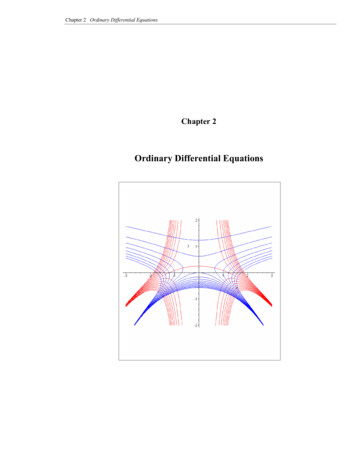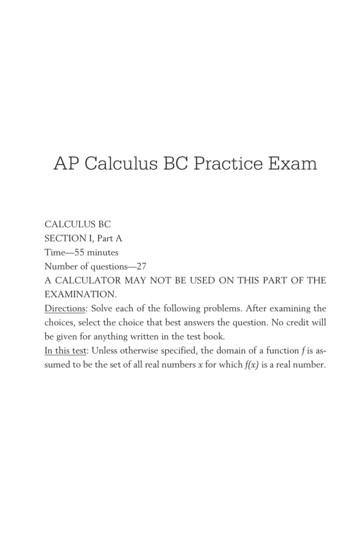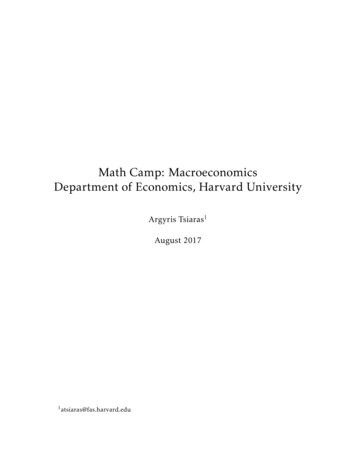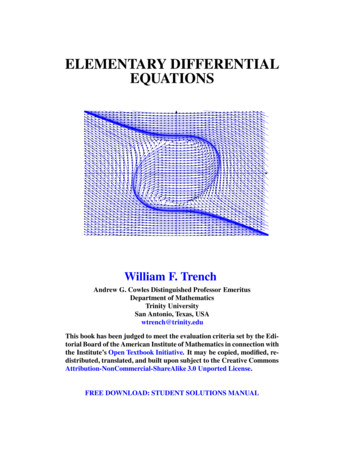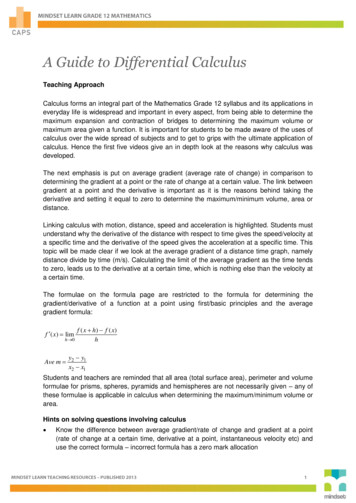
Transcription
A Guide to Differential CalculusTeaching ApproachCalculus forms an integral part of the Mathematics Grade 12 syllabus and its applications ineveryday life is widespread and important in every aspect, from being able to determine themaximum expansion and contraction of bridges to determining the maximum volume ormaximum area given a function. It is important for students to be made aware of the uses ofcalculus over the wide spread of subjects and to get to grips with the ultimate application ofcalculus. Hence the first five videos give an in depth look at the reasons why calculus wasdeveloped.The next emphasis is put on average gradient (average rate of change) in comparison todetermining the gradient at a point or the rate of change at a certain value. The link betweengradient at a point and the derivative is important as it is the reasons behind taking thederivative and setting it equal to zero to determine the maximum/minimum volume, area ordistance.Linking calculus with motion, distance, speed and acceleration is highlighted. Students mustunderstand why the derivative of the distance with respect to time gives the speed/velocity ata specific time and the derivative of the speed gives the acceleration at a specific time. Thistopic will be made clear if we look at the average gradient of a distance time graph, namelydistance divide by time (m/s). Calculating the limit of the average gradient as the time tendsto zero, leads us to the derivative at a certain time, which is nothing else than the velocity ata certain time.The formulae on the formula page are restricted to the formula for determining thegradient/derivative of a function at a point using first/basic principles and the averagegradient formula:f ( x) limh 0Ave m f ( x h) f ( x )hy2 y1x2 x1Students and teachers are reminded that all area (total surface area), perimeter and volumeformulae for prisms, spheres, pyramids and hemispheres are not necessarily given – any ofthese formulae is applicable in calculus when determining the maximum/minimum volume orarea.Hints on solving questions involving calculus Know the difference between average gradient/rate of change and gradient at a point(rate of change at a certain time, derivative at a point, instantaneous velocity etc) anduse the correct formula – incorrect formula has a zero mark allocation
Know that there are two ways to determine the rate of change at a certain time or thegradient at a point or the derivative at a point namely: first/basic principles and usingdifferential rules. Never use basic/first principles unless specifically asked to do so.Ensure that you know the applications of calculus:o Sketching cubic functions (calculating x-and y- cuts and the turning points) andfinding the equation, if the sketch is giveno Determining the equation of a tangent to a curveo Determining the maximum/ minimum volume/area/distance (first derivative 0)o Determining the point of inflection (second derivative 0)o Being able to sketch a derivative function form a function and vice versa (even if theequation of the function is not given)o Know where the function increases/decreases and the role of the gradient indetermining whether a function is increasing/decreasing over an interval.o Know the Total Surface area, volume and perimeter formulae of especially prismsand pyramids
Video SummariesSome videos have a ‘PAUSE’ moment, at which point the teacher or learner can choose topause the video and try to answer the question posed or calculate the answer to the problemunder discussion. Once the video starts again, the answer to the question or the rightanswer to the calculation is given.Mindset suggests a number of ways to use the video lessons. These include: Watch or show a lesson as an introduction to a lesson Watch of show a lesson after a lesson, as a summary or as a way of adding in someinteresting real-life applications or practical aspects Design a worksheet or set of questions about one video lesson. Then ask learners towatch a video related to the lesson and to complete the worksheet or questions, either ingroups or individually Worksheets and questions based on video lessons can be used as short assessments orexercises Ask learners to watch a particular video lesson for homework (in the school library or onthe website, depending on how the material is available) as preparation for the next dayslesson; if desired, learners can be given specific questions to answer in preparation forthe next day’s lesson1. Introducing CalculusThis video gives a brief introduction to Calculus by looking at where Calculus is used indifferent spheres of life and the history of Calculus. It also looks at the reasons whyCalculus was invented.2. Why Calculus?We briefly recap the maximisation problem that we started in the previous lesson as wellas the fact that an intuitive solution is contradicted by the reality of our exploration. Tounderstand the problem better we introduce some graphing software that draws the graphof the function that describes the problem.3. Finding the Tangent IIn this lesson we come to the realisation that to determine the co-ordinates of the turningpoint it would be useful if we could determine the point on the graph at which the tangentto the graph has a gradient of zero.4. Finding the Tangent IIIn this lesson we determine the gradient of a line through a point of interest on a curveand another point on the curve which we bring increasingly closer to the point of interest.With time we begin to observe patterns.5. Introducing the Derivative FunctionWe continue with the numerical exploration that we started in the previous lesson andextend it to other functions.6. Working with the Derivatives FunctionIn this lesson we introduce the notion of a limit and use this to develop rules fordifferentiation of functions.
7. Determining the Derivatives using First PrinciplesIn this lesson we continue with calculating the derivative of functions using first or basicprinciples. In the first example the function is a two term and in the second example thefunction is a fraction.8. Determining the Derivative using Differential RulesWe look at the second way of determining the derivative, namely using differential rules.We also look at the steps to take before the derivative of a function can be determined.9. Sketching a Cubic FunctionWe go through the stages of drawing the graph of a third degree function step by step.We also use this lesson to answer a typical examination question in which we determinethe equation of a tangent to a graph.10. Exploring the Rate of ChangeIn this lesson we explore how the gradient of the tangent to a function (derivative) and therate of change of a function are related.11. Determining the Point of InflectionWe define the point of inflection. We then proceed to highlight two possible ways todetermine the point of inflection of a curve.12. OptimisationIn this lesson we explore how the gradient of the tangent to a function (derivative) relatesto maximizing or minimizing a function. We look at how calculus is applied inmaximizing/minimizing volumes, areas and distances.Resource MaterialResource materials are a list of links available to teachers and learners to enhance their experience ofthe subject matter. They are not necessarily CAPS aligned and need to be used with discretion.1. Introducing subject lculus.html2. Why Calculus?3. Finding the Tangent dfhttp://www.curriki.org/xwiki/bin/download/Coll MathematicsGrade12Ch40DifferentialCalculus.pdfThis slide show gives us an indepth look at the wide range ofuses of calculus.This article highlights the historyof Calculus, its origin and uses.This site gives us an in depthtutorial on all the topics dealt within Calculus.This site deals with introductorynotes on calculus that will assistthe weaker learners with preCalculus questions.This site gives comprehensivenotes and good examples on avariety of sections within calculus,which includes modelling, limitsaverage gradient, rate of changeand much more.
http://cnx.org/content/m39270/1.1/4. Finding the tangent IIhttp://www.youtube.com/watch?v 7Ufv0X5y0fc5. Introducing the DerivativeFunction6. Working with the DerivativeFunction7. Determining the Derivativesusing First Principles8. Determining the Derivativeusing Differential Rules9. Sketching a Cubic Function10. ExploringChange11. DeterminingInflection12. OptimisationtheRatethe x?fileticket t gov.za/LinkClick.aspx?fileticket ion.gov.za/LinkClick.aspx?fileticket l%2BFVxMrqH0U%3D&The notes and video in this sitedeals with introduction to calculus,average gradient and limits.This is a YouTube video (Mindset)that deals with a revision onCalculus questions.Gives explanations and exampleson determining the derivativeusing first principlesExamples on determining thederivative and the differentialrulesExamplesonfindingthederivative using differential rulesGives explanations and exampleson determining the derivativeusing first principlesExamples on determining thederivative and the differentialrules.Gives explanations and exampleson determining the derivativeusing differential rules.Examples on determining thederivative using first principlesGives explanations and exampleson determining the derivativeusing differential /DiffFormulas.aspxExamples on determining thederivative and the lasses/CalcI/Tangents alcI/ShapeofGraphPtII.aspxExamples in this video deals withfinding the equation of a tangentto a curve, amongst othercalculations.Deals with important aspects ofgraph alcI/ShapeofGraphPtII.aspxDeals with the application of thesecond derivative.https://www.math.ucdavis.edu/ This worksheet gives us an manyexamples of maxima and minimahttp://www.youtube.com/watch?v 3aVT9d RTskThis video gives an example onhow to determine the asses/CalcI/RelatedRates.aspxThis tutorial deals with exampleson rate of w.education.com/studyhelp/article/optimization answer/This video deals with optimizationexamples.This video gives us moreoptimization examples
TaskQuestion 1Consider the function: f ( x) x 2 . Calculate the average gradient of f (x) between :1.1 ( 1; 1) and ( 2; 4)1.2 ( 5; f (5)) and ( 3; f (3))Question 2Calculate:2.12.2Question 3Use the gradient formula gradient (m) f ( x h) f ( x )to determine the gradients in termshof h for any two points on the functions:23.1 f ( x) x3.2 f ( x) x33.3 f ( x) x3.4 f ( x) aa constant3.5 f ( x) x 2 x .Question 4Determine the derivative of each of the following functions by using first principles:4.1 f ( x) 54.2 f ( x) 4 x 24.3 f ( x) x 2 xQuestion 5Determine the derivative of the following function by using first principles:f ( x) 1x2Question 6Find the value of x that will give a maximum volume and determine the maximum volume ifV ( x) 4 x3 80 x 2 400 xQuestion 7Given the function f ( x) 2 x3 4 x2 2 x . Determine the points on the curve where thegradient is equal to 10.
Question 8Determinedof f ( x) in each of the following if:dx28.1 f ( x) 3( x 2)( x 4)8 x3 3 x 2 x 12x46 8.3 f ( x) 3xx28.2f ( x) x 2 3x 48.4 f ( x) x 1Question 99.1 Make a neat sketch graph of f ( x) x3 9 x 2 24 x 20 , clearly indicate all turningpoints and points of intersection with the axes.9.2 Make a neat sketch graph of f ( x) x3 4 x2 4 x and then determine the equation ofthe tangent to f (x) at x 3Question 10The graph below shows the curve off ( x) x3 4 x 2 11x 3010.1 Determine the coordinates of the point of inflection of the graph.10.2 Determine the coordinates of the turning points of the graph10.3 For which values of x will f(x) decrease and for which values of x will f(x)increase?
Question 11Consider the graph of f ( x) 2 x3 7 x2 3x 18 sketched below:11.1 Use the words increasing, decreasing and constant to describe what is happening tothe function value : In the interval AB In the interval DE11.2 The coordinates of A is (– 4; – 22) and B is (– 3; 0) Determine the average rate of change between points A and B Determine the rate of change at point B
Question 12A parabola,f ( x) 2 x 2 6 x 8and a line graph,g ( x) x 1are sketched. Thegraphs intersect at points C and D. Line AB is parallel to the y-axis with point A on theparabola and point B is on the straight line. Determine the maximum length of line ABbetween points C and D.Question 13The average mass of a baby in the first twenty days of life is given by the equationt3t2m(t ) 3648 36where m is the mass in kilogram and t is the time in days.13.1 What is the average mass of a baby at birth, according to the equation?13.2 For a short period of time after birth it is usual for a baby to lose mass, When,according the equation, does the baby’s mass reach a minimum?13.3 After how many days would the baby’s mass once again be the same as its mass atbirth?
Task AnswersQuestion 11.1Ave m y2 y1 4 1 3x2 x1 2 11.2 f ( x) x 2x 5 y 25 (5;25)x 3 y 9 (3;9)y y1 25 9Ave m 2 8x2 x15 3Question 22.12.2Question 33.1f ( x) x 2gradient (m) f ( x h) f ( x )h( x h) 2 x 2 h2x 2 xh h 2 x 2 h22 xh hh(2 x h) 2x hhh3.2f ( x) x3f ( x h) f ( x )h3( x h) x 3 h3x 3 x 2 h 3xh 2 h3 x3 h223x h 3xh h3 h(3x 2 3xh h 2 ) hh22 3 x 3 xh hgradient (m)
3.3f ( x) xf ( x h) f ( x )hx h x hh 1hgradient (m) 3.4f ( x) af ( x h) f ( x )ha a h0 0hgradient (m) 3.5f ( x) x 2 xf ( x h) f ( x )h2( x h) ( x h) ( x 2 x ) h22x 2 xh h x h x 2 x h22 xh h h h(2 x h 1) 2x 1hhgradient (m) Question 44.1f ( x) 5f ( x h) f ( x )h hh5 5 limh h h0 limh h h 0 f ( x) lim
4.2f ( x) 4 x 2 f ( x) limh hf ( x h) f ( x )hf ( x) 4 x 2 . f ( x h) 4( x h) 2 4( x 2 2 xh h 2 ) 4 x 2 8 xh 4h 2 4 x 2 8 xh 4h 2 ( 4 x 2 )h hh lim 4 x 2 8 xh 4h 2 4 x 2 )h hh lim 8 xh 4h 2h hhh( 8 x 4h) limh hh lim 8 x 4h 8 x limh h4.3f ( x) x 2 x f ( x) limh hf ( x h) f ( x )hf ( x) x 2 x. f ( x h) ( x h) 2 x h ( x 2 2 xh h 2 ) x h x 2 2 xh h 2 x hx 2 2 xh h 2 x h ( x 2 x)h hh limx 2 2 xh h 2 x h x 2 xh hh lim2 xh h 2 hh hhh(2 x h 1) limh hh lim 2 x h 1 2 x 1 limh h
Question 5Question 6V ( x) 4 x3 80 x 2 400 xV ( x) 12 x 2 160 x 400for maximum, V ( x) 0 12 x 2 160 x 400 0 3 x 2 40 x 100 0 3 x 10 x 10 0 x 10or x 10332 10 10 10 10 V 4 80 400 592, 6cm3 3 3 3 3 V 10 4 10 80 10 400 10 0cm332 Volumemax 592, 6cm3
Question 7Given the functionf ( x) 2 x3 4 x 2 2 xDetermine the points on the curve where the gradient is equal to 10f ( x) 2 x3 4 x 2 2 xm f ( x) 6 x 2 8 x 2 10 6 x 2 8 x 2 10 6 x2 8x 8 0 2 3x 2 4 x 4 0 3x 2 x 2 0 x 2or x 233x 22 2 2 2 100 2 100 y 2 4 2 ; 3 3 3 3 27 3 27 x 2 y 2 2 4 2 2 2 4 2; 4 32Question 88.1f ( x) 3( x 2 2)( x 4) 3( x3 4 x 2 2 x 8) 3 x3 12 x 2 6 x 24 d f ( x) dx 9 x 2 24 x 68.28 x3 3x 2 x 1f ( x) 2x8 x3 3x 2 x1 2x 2x 2x 2x31 1 4 x 2 x x 122 2d f ( x) 3 131 8 x x 2 or 8 x 2dx2 22 2x
8.3f ( x) 46 x 3 x2 d f ( x) dx41x2 62x3 4x 1,5 4x 123x 2 3x 4x 1 x 1 x 4 x 1 x 4d f ( x) dx 1Question 99.1 6x28.4 1212 1 4 x 1,5 6 x 323 2 xf ( x) f ( x) x3 9 x2 24 x 20 23
9.2f ( x) x3 4 x 2 4 xf ( x) x3 4 x 2 4 xif x 3, then y (3)3 4(3) 2 4(3) 3 (3; 3) is a point on the tangentm f ( x) 3x 2 8 x 4 mx 3 3(3) 2 8(3) 4 7 mtangent 7 y y1 m( x x1 )y 3 7( x 3) y 7 x 18Question 1010.1f ( x) x3 4 x 2 11x 30f ( x) 3 x 2 8 x 11f ( x) 6 x 8 0 6 x 88 4 x 6 332286 4 4 4 4 y f 4 11 30 10,627 3 3 3 3 4 ; 10,6 3
10.2f ( x) x3 4 x 2 11x 30f ( x) 3 x 2 8 x 11 03 x 2 8 x 11 0 3x 11 x 1 0 x 11or x 1332400 11 11 11 11 y f 4 11 30 14,6333327 11 ;14,8 3 y f 1 1 4 1 11 1 30 3632 1; 36 x 1 and x 10.3 Decreasing:Increasing: 1 x 113113Question 1111.1AB: The function is increasingDE: The function is decreasing11.2Average rate of change 22 0 1 4 ( 3)f ( x) 6 x 2 14 x 3 Rate of change at B ( 3;0) f ( 3) 6( 3) 2 14( 3) 3 9Question 12A( x; 2 x 2 6 x 8) and B( x; x 1) distance AB( DAB ) 2 x 2 6 x 8 ( x 1) 2 x 2 6 x 8 x 1 2 x 2 7 x 9 D AB ( x) 4 x 7For max distance D AB ( x) 0 4 x 7 0 4 x 77 x 42121 7 7 max distance DAB 2 7 9 15,1 units8 4 4
Question 1313.1t3t2 3648 36m(t ) At birth, t 0 m(0) 00 3 3kg648 3613.2t3t2 3648 36m(t ) 3t 2 2tt2t 0 648 36216 18Min / Max. m (t ) 0m (t ) 216t2t 0216 18 t 2 12t 0 t (t 12) 0 t 0 t 12 after 12 days13.3m(t ) t3t2 3 3648 36 648t3t2 3 3648 36t3t2 0648 36 t 3 18t 2 0 t 2 (t 18) 0 t 0 t 18 after 18 days
AcknowledgementsMindset Learn Executive HeadContent Manager Classroom ResourcesContent Coordinator Classroom ResourcesContent AdministratorContent DeveloperContent ReviewerDylan BusaJenny LamontHelen RobertsonAgness MunthaliRonald P. JacobsRaquel NeilsonDancun ChirigaProduced for Mindset Learn by TrafficFacilities CoordinatorFacilities ManagerDirectorEditorPresenterStudio CrewGraphicsCezanne ScheepersBelinda RenneyAlriette GibbsNonhlanhla NxumaloSipho MdhluliJT MedupeAbram TjaleWayne Sanderson.This resource is licensed under a Attribution-Share Alike 2.5 South Africa licence. When using thisresource please attribute Mindset as indicated athttp://www.mindset.co.za/creativecommons
1. Introducing Calculus This video gives a brief introduction to Calculus by looking at where Calculus is used in different spheres of life and the history of Calculus. It also looks at the reasons why Calculus was invented. 2. Why Calculus? We briefly recap the maximisation problem that we started in the previous lesson as well



